Choosing your first Japanese knife can raise a few questions about which style of knife to choose and even what to look for when buying a Japanese knife. We have created the ultimate guide with some tips on how to go about deciding on a knife and ensuring you are getting the genuine article.
Choosing a Japanese knife requires understanding a little about Japanese knives, taking care of the knives, what to look for in a Japanese knife, and knowing the difference between Japanese-style knives and genuine Japanese knives. You need to be wary of internet scams selling fake Japanese knives.
Deciding to purchase your first Japanese knife is a big commitment. These knives are not cheap, so understandably, you approach the process with some trepidation. Our guide will give you the knowledge to know what you want and what to look for in a Japanese knife to enable you to purchase with confidence.
If you are interested in checking out the best Japanese knives (made by Hayate Yoshihiro) we recommend and use, you can find them by clicking here (Amazon link).

How To Choose A Japanese Knife
There is little doubt that Japanese kitchen knives are some of the best knives in the world, and once you experience using one, you will be amazed by the knife’s performance.
However, when choosing your first Japanese knife, there are many choices and decisions to be made. There are also some aspects of Japanese knives you need to be aware of and questions that need to be answered before finalizing your decision.
Japanese Knives Are Not All-Purpose Knives
Japanese knives may be sought after as prestigious kitchen implements, and many people who purchase these knives are not aware that the knives are designed for specific kitchen tasks.
Japanese knives are designed and precision-made for specific cutting and processing tasks, and they perform those jobs really well. Using a Japanese knife for a purpose outside its intended range can damage or destroy the knife. They are not intended to be general-purpose kitchen knives.
You need to be aware that the knife you purchase will be designed for a specific purpose and should only be used in that role. This will be a determining factor in deciding what Japanese knife you should invest in.
When choosing the type of Japanese knife to purchase, it is best to choose the style of knife that you will get the most use out of.
TIP: Using your Japanese knife for all purposes is one of the most common beginner mistakes. Find out what is not allowed to cut with Japanese knives in the article below:
Complete List: What NOT TO CUT With Japanese Knives & Why?
How Are You Going To Sharpen The Knife?
All knives, including Japanese knives, become dull with use. Japanese knives are made from extremely hard steel and have specific grinds on the bevels and the edge.
This means they generally require specialized sharpening tools, techniques, and skills. Will you be sharpening your knife yourself, or will you be outsourcing the sharpening?
Learning how to sharpen your Japanese knife yourself is the best option, but many people do not have the time or inclination to learn this skill.
Before purchasing your knife, you need to have a plan in mind for how you will sharpen the knife when the need arises.
BTW: If you want to know more about Japanese and other knives and their sharpening, check out the books listed above. These books are recommended by professional sharpeners and knife makers (Amazon links):
- Japanese Kitchen Knives: Essential Techniques and Recipes
- The Knifenerd Guide to Japanese Knives
- Knife: The Culture, Craft, and Cult of the Cook’s Knife
- Sharp: The Definitive Introduction to Knives, Sharpening, and Cutting Techniques, with Recipes from Great Chefs
Western Japanese-Style Knives Are not Japanese Knives
There are many knife makers in the Western world who make Japanese-style kitchen knives and market them as such.
Western Japanese-style knives are styled along the same lines as Japanese knives, but they are not genuine articles. The steel is not the same as Japanese steel and cannot be hardened to a high HRC level. The bevels, grinds, and handles on these knives can also differ.
If you are looking specifically for a Japanese kitchen knife, you need to ensure that the knife you purchase is made in Japan and that Japanese steel is used.
There are many scams, particularly online, where unscrupulous people sell substandard knives as genuine Japanese knives.
These scammers know that people are willing to pay a higher price for Japanese knives, and the knives are popular in the Western world, which presents them with an opportunity to scam unsuspecting buyers.
TIP: Unfortunately, the internet is full of scammers selling fake Japanese knives. The good news is that you can easily detect fake Japanese knives! Find out what to focus on in the article below:
Spotting FAKE Japanese Knives: 8 Features To Watch Out For
What Should I Look For In A Japanese Knife?
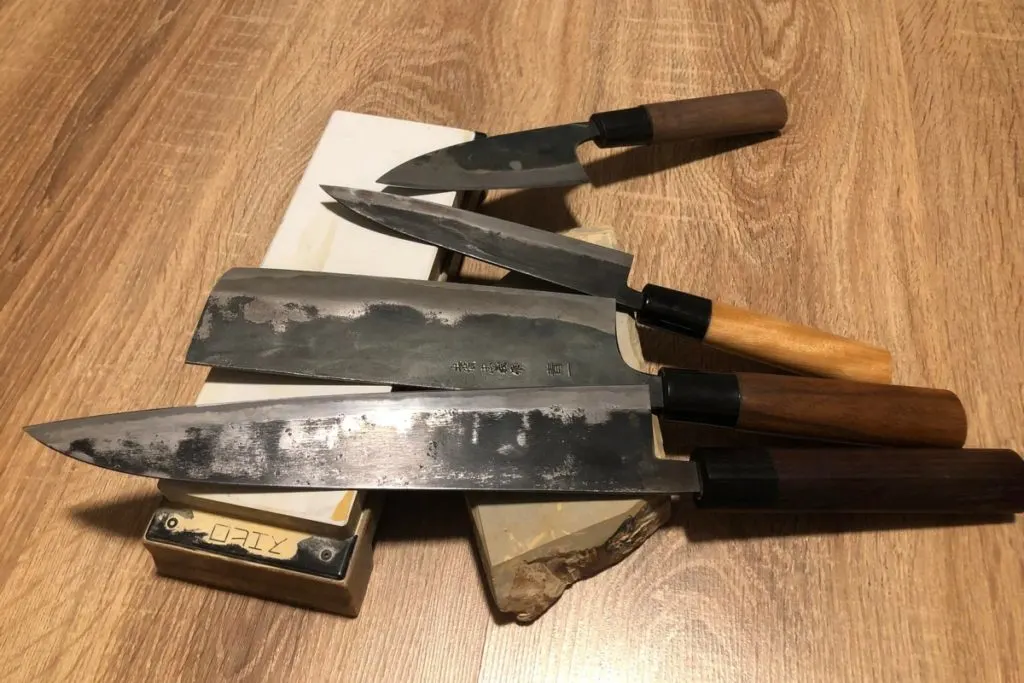
When considering purchasing a Japanese knife, you should evaluate several aspects of these knives to make the right selection.
When purchasing your first Japanese knife, you should choose a double bevel knife with a flat grind, a length that suits your build and hand size, and a traditional Wa-style handle. The knife should be made from Japanese steel, such as VG-10, and hardened above 60-HRC.
This is especially true when buying your first Japanese knife. Aspects such as the bevels, grind type, length, and even handle shape should be given attention.
Which Bevels Should You Opt For On A Japanese Knife?
Many Japanese knives will come in two bevel options, depending on the purpose of the knife. Many original Japanese knives were single-bevel only, but when the Western world showed interest in the knives, double-bevel options were offered to accommodate this market.
A double bevel is where the steel is ground down on both sides of the blade towards the knife’s cutting edge. A cross-section view of the blade would look V-shaped, with a sharp edge at the bottom of the V.
A single bevel knife is where the left side of the knife is flat, and only the right side is ground down at an angle to produce a fine cutting edge. This single-bevel blade would be for a right-handed person.
A left-handed person would require the flat side of the knife to be on the right-hand side of the blade. However, traditionally, no left-handed knives were made in Japan because left-handed people were ostracized and often killed, as being left-handed was considered unnatural.
It is only in recent times that Japanese knife makers have started producing single-bevel knives for left-handed people, mostly to cater to the Western market.
Our recommendation for your first Japanese knife is to opt for a double-bevel blade. These knives are easier to sharpen and maintain than a single-bevel knife.
Single-bevel knives are generally considered for professional chefs since the knives require not only specialized sharpening but also different techniques in their use.
TIP: Japanese knives are quite expensive so it is always good to know how to care for them. Check out the complete guide about all you need to know in the article below:
How To Care For Japanese Knives: The Complete Guide
What Grind Type Should You Select For A Japanese Knife?
Japanese kitchen knives can have the bevels ground in two main ways: a flat grind or a hollow grind. A first Japanese knife should have the right grind to make it easier to sharpen and take care of the knife.
Flat ground blades are significantly easier to sharpen and maintain the edge of the knife. For this reason, the grind profile on your first Japanese knife should be a double-bevel flat grind. A hollow ground blade will be sharper but is more difficult to sharpen.
Flat grinds are exactly what they sound like; there is no concave shape to the grind. The bevels have flat sides in the traditional V-shape of the blade.
A hollow grind on a knife is where the bevels have a slightly concave shape. This allows the edge to be extremely thin and sharp.
This is the traditional grind on cutting tools such as straight razors. While it produces a very sharp edge, these blades are difficult to sharpen.
What Length Japanese Knife
Japanese knives come in a range of sizes, even within the same style of knives. For example, the blade length of a Gyuto can vary from 8.2 inches (210mm) to 10.6 inches (270mm).
Smaller-stature people with smaller hands commonly prefer a shorter knife. A longer blade in the hands of such a person will feel unwieldy. Conversely, taller people with larger hands prefer a knife with a longer blade, as the shorter length does not offer the same agility.
If you are uncertain which length to choose, a length somewhere in the middle of the range is a good place to start.
You can also examine your current knives and evaluate which length blade you feel more comfortable and confident using. This will give you a good estimate of the right blade length for your build.
What Handle Shape Should You Choose In A Japanese Knife?
If you are looking for a traditional Japanese knife, you should choose a knife with a traditional handle. Many Japanese knife manufacturers have produced knives with Western-style handles.
This takes away some of the lightness of the handle and, consequently the agility of the blade. The traditional handle style on a Japanese knife is a Wa handle.
The Wa-style handle is the best handle design to select for your first Japanese knife. The blades are designed to work with this handle style to produce the correct balance and hand position for using the knife for its intended purpose. Western-style handles change your posture on the knife.
A Wa handle is narrower than a Western-style knife handle and is often wider than the base of the handle, tapering slightly toward the blade.
The cross-section of the handle is generally oval, D-shaped, or octagonal. The handles are mostly made from wood, and the tang of the blade does not extend all the way down the length of the handle.
This produces a lighter overall feel to the handle and a balance that is focused towards the blade. It also makes it easier to adjust your grip forward or back on the handle or pinch up on the blade for different tasks with the knife.
Did you know you can replace the handle of your Japanese knife if needed? Yes, it is possible in most cases. Check out the step-by-step guide on how to do it in the article below:
7 Simple Steps: How To Replace A Japanese Knife Handle
How Do You Know If A Japanese Knife Is Good?
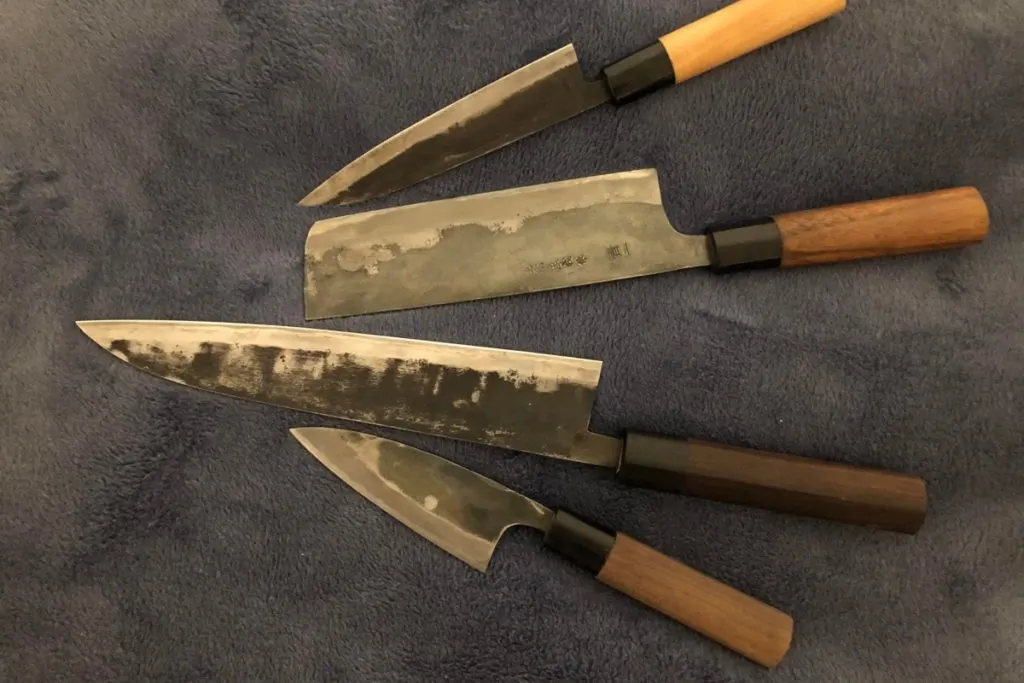
With the variety of knives available on the market, many claiming to be Japanese knives, it is difficult to tell the difference between genuine and fake.
We have some pointers that will help you separate the junk from the genuine.
| Pointer | Explanation |
|---|---|
| 1. No country of origin | If the packaging does not say “Made In Japan,” you should take a closer look, as this is an indicator it may not be genuine. |
| 2. No town or region of origin | Japanese people are a proud nation that values hard work and quality products. Consequently, knife makers will often place the name of the region, town, and even the village where the knife was made. |
| 3. No mention of the steel type | If the steel type is not mentioned, or the type of steel used and cladding and the steel used as the core, you should be wary of the product. Core steel is important in the manufacture of Japanese knives, so the manufacturer should always mention the core steel type in the documentation. |
| 4. Damascus steel | 6. Limited-time offers |
| 5. Hugely discounted pricing | Traditional Japanese knives are not made from Damascus steel. Some Japanese manufacturers have started producing Damascus steel knives because of their appeal, especially in the Western world. |
| 6. Limited time offers | Any marketing gimmick that is trying to instill a sense of urgency for you to make a purchase by limiting the time of the offer or the limited quantity of items should be approached with caution. |
| 7. Claims that the knife will never dull | All knives will become dull and require sharpening. A manufacturer claiming their knives will never become dull is deceptive marketing, and you should be wary of the product. |
| 8. Non-Japanese companies claiming to use Japanese steel in their knives | Companies outside of Japan claim that their knives are made from VG-10 or other Japanese steels that are not genuine Japanese knives. |
| 9. The price is too low | If the knife’s price is much lower than other Japanese knives, you should view the product with suspicion. |
The best way to ensure you are buying a genuine product is to research the manufacturer to establish whether the company has its own website, reviews from other customers, and the country where the company is located.
Some local suppliers will import knives to sell in your region, but if the company is offering genuine Japanese knives, they will be transparent about the source of their knives.
TIP: You should already know how to spot fake Japanese knives. One of the main factors of a real Japanese knife is the price. Check out why Japanese knives are worth their price in the article below:
9 Reasons Why Japanese Knives Are Worth Their Price
Which Japanese Knife To Buy First
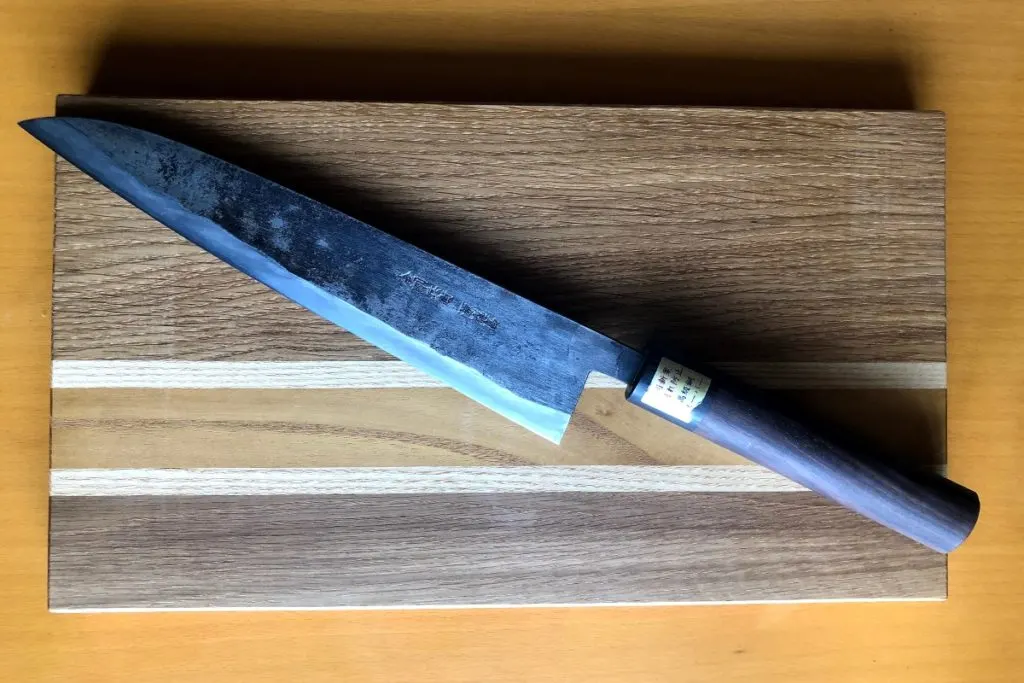
One of the major dilemmas for people buying their first Japanese knife is which knife style to choose. Japanese knives are made for certain functions in the kitchen, so you should choose a knife that you will get the most out of for your type of cooking.
The best Japanese knife to buy first will be the one you will get the most use and value out of in your kitchen. The most common first Japanese knife is the Gyuto, the Japanese version of a chef’s knife. Other good options for your first Japanese knife are a Santoku or a Deba.
For a first Japanese knife, we recommend one of the following selections.
- Gyuto
This knife is the Japanese version of the western Chef’s knife. This is a versatile knife that can be used to cut meat and fish and process vegetables and fruit. Vegetables can be cut with a rocking motion with this knife.
If you are interested in buying a high-quality Gyuto knife we recommend checking out this knife made by the Yoshihiro company (Amazon link).
- Santoku
This knife has a tall blade, but it is shorter and has a less pointed tip than the Gyuto. It is perfect for cutting smaller pieces of meat, cutting fish, and vegetables. The Santoku has a straighter blade which makes using a rocking motion to cut vegetables difficult. However, a straight up and down chopping motion can be used.
If you are interested in buying a high-quality Santoku knife we recommend checking out this knife made by the Yoshihiro company (Amazon link).
- Deba
This is a robust knife intended for processing meat, fish and breaking down and dressing poultry. The heavier blade is ideal for cutting through fish bones during processing or the smaller bones in poultry.
If you are interested in buying a high-quality Deba knife we recommend checking out this knife made by the Yoshihiro company (Amazon link).
TIP: A lot of people think that buying a Japanese knife in Japan is cheaper. Is that true? Find out the answer in the article below:
Are Japanese Knives Cheaper In Japan? Complete Breakdown
Best Websites To Buy A Japanese Knife
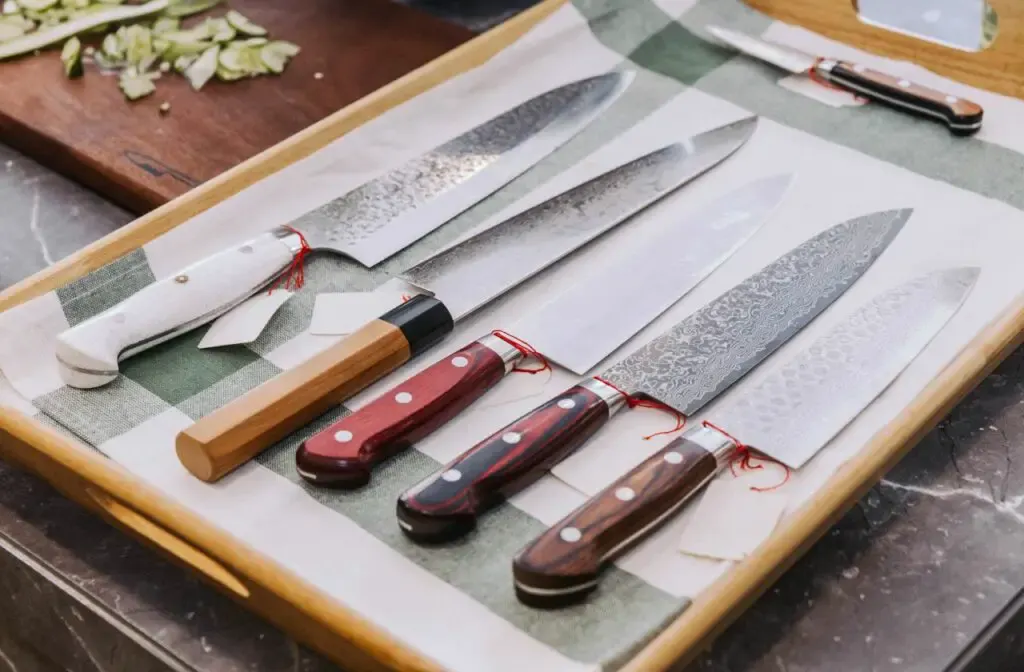
There are several reputable places online where you can source genuine Japanese knives of good quality. It is always prudent to check reviews regarding online suppliers and do your own research before purchasing.
Some websites you can take a look at to source your first Japanese knife are:
- Chef Knives To Go
- Japanese Chefs Knife
- Chubo Knives
- Hocho Knife
- Cutlery And More
- Japanese Knife Imports
This is a good selection of reputable online stores that sell known and respected Japanese knife brands.
Choosing A Japanese Knife: FAQ
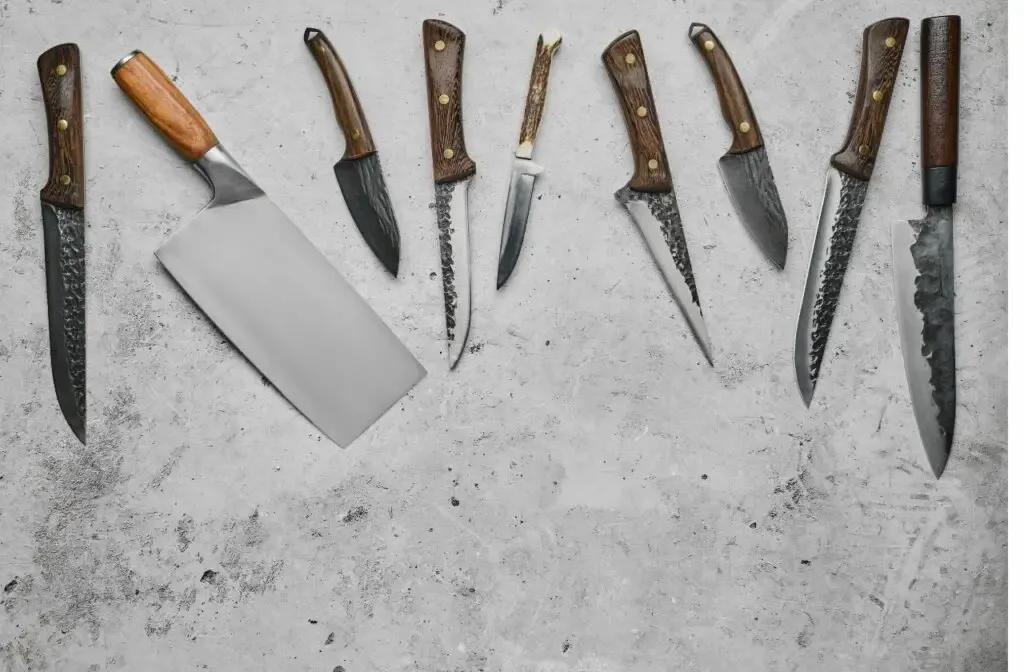
Q: Why Choose a Japanese Knife for My Kitchen?
A: Japanese knives are renowned for their exceptional craftsmanship, sharpness, and durability. They are often made using high-quality steel and traditional forging techniques, ensuring precision and efficiency in various culinary tasks.
Q: What Differentiates Genuine Japanese Knives from Western Japanese-Style Knives?
A: Genuine Japanese knives are crafted in Japan using specific types of Japanese steel and traditional knife-making techniques. In contrast, Western Japanese-style knives may mimic the style but often utilize different materials and manufacturing processes.
Q: How Do I Identify a High-Quality Japanese Knife?
A: Look for key indicators such as the type of steel used, craftsmanship quality, balance, sharpness, and the manufacturer’s reputation. Genuine Japanese knives often provide details about the steel type, manufacturing region, and artisan information.
Q: What Are the Different Types of Japanese Knives and Their Uses?
A: Japanese knives come in various types, each designed for specific tasks. For instance, Gyuto is versatile, Santoku is great for slicing, dicing, and chopping, while Deba is used for filleting fish. Each type has unique features suited to particular culinary activities.
Q: How Do I Properly Maintain and Store My Japanese Knife?
A: Ensure that the knife is hand-washed and dried immediately after use to prevent rusting. Store it in a good quality knife block, magnetic strip, or blade guard to protect the edge. Regular sharpening and occasional honing will also maintain its optimal performance.
Q: What Is the Best Technique for Sharpening Japanese Knives?
A: Japanese knives are often sharpened using whetstones. The technique involves soaking the stone, maintaining a consistent angle, and smoothly sliding the knife across the stone in a controlled manner. Different grit levels are used for sharpening, honing, and polishing the blade.
Q: Can I Use My Japanese Knife for All Kitchen Tasks?
A: No, Japanese knives are often task-specific. Using them for inappropriate tasks like cutting through bones or frozen food can damage the blade. Always refer to the knife’s intended use to ensure longevity and maintain performance.
Q: Where Can I Purchase Authentic Japanese Knives?
A: Authentic Japanese knives can be purchased from reputable online retailers, specialized kitchenware stores, or directly from manufacturers. Ensure to verify the authenticity through product details, reviews, and seller information.
Q: Is Investing in a High-End Japanese Knife Worth It for Home Cooks?
A: Yes, investing in a high-end Japanese knife can enhance your cooking experience due to its sharpness, precision, and durability. While it may be an investment, the longevity and performance of a quality Japanese knife can offer value over time.
Q: How Do I Choose the Right Type of Japanese Knife for My Cooking Needs?
A: Consider the tasks you frequently perform in the kitchen. If you often chop vegetables, a Santoku might be suitable. For versatile cutting needs, a Gyuto might be ideal. Assess your cooking style, preferred ingredients, and cutting techniques to determine the right type.
Conclusion
The decision to purchase a Japanese knife is not a decision you will regret. Once you have received your knife, you will wonder why you didn’t make the decision earlier!
Japanese knives are a pleasure to use in the kitchen but require different care and treatment from other kitchen knives. Buying a Japanese knife is not a simple decision but rather a commitment!
TIP: Using whetstones is the traditional way of knife sharpening. Check out the ultimate guide on how to sharpen a knife with a whetstone in the article below:
Step-By-Step GUIDE: How To Sharpen A Knife With A Whetstone

